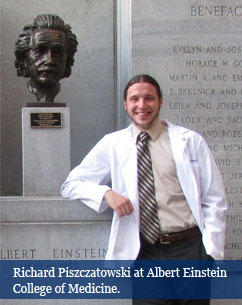Newsroom Archive
 When Richard Piszczatowski (BS ’11) originally decided to attend John Jay, he had envisioned himself as a medical examiner, conducting autopsies and determining cause of death among many other responsibilities.
When Richard Piszczatowski (BS ’11) originally decided to attend John Jay, he had envisioned himself as a medical examiner, conducting autopsies and determining cause of death among many other responsibilities.
However, after he volunteered at a local hospital, he realized that his true passion lay with the health and well-being of living patients.
“I realized I genuinely enjoyed communicating, interacting and dealing with patients as opposed to examining deceased ones,” said Piszczatowski. By his sophomore year, Piszczatowski decided he would change his career path and pursue an MD. But since John Jay does not offer a pre-med major, he had to weigh his options carefully.
“John Jay is actually a hidden gem for pre-medical students,” he observed. “The science majors at John Jay fulfill pre-medical requirements and offer an affordable and very personalized route toward applying to medical school.” Although most students who are interested in medical school often consider schools that offers a conventional pre-med major, Piszczatowski liked his John Jay professors and classes.
“I figured all the classes are the same, and it’s so affordable, so I decided to stay. I ended up receiving the best education and had a great time.”
Now enrolled in the MD/PhD program at Albert Einstein College of Medicine, Piszczatowski hopes to enter a residency program after he graduates and eventually find a position as a physician and open up his own lab at a university. He credits his work with his mentor, Professor Nathan H. Lents, Deputy Chair of the Department of Sciences, as the cornerstone of his exceptional education at John Jay.
“Undergraduate science research at John Jay is booming,” he said. “If I had to pick one reason for my success, it would be my research, and my mentor's guidance and motivation to pursue my own project.”
Piszczatowski had read in research conducted by other scientists that the protein being studied by Professor Lents’s group was, in fact, abundant in platelets. Yet the cells in bone marrow that produce these platelets did not contain this protein, so its origin was a mystery.
Professor Lents allowed Piszczatowski to design and execute the research project while he provided guidance. “Dr. Lents took a risk with me. But his confidence in me made me become a researcher instead of someone just working in a research lab,” said Piszczatowski.
The faculty-student duo plan to publish two papers within the next year and present their work at four or five different conferences. They recently delivered a lecture at the annual conference of the International Society on Blood Transfusion in Kuala Lumpur, Malaysia, titled Myeloid Zinc Finger-1 (MZF-1) Transcriptionally Regulates CCN2 and CCN3 in the Hematopoietic Compartment, with Important Implications for Blood and Bone Marrow Donation..
“Richard was a joy to have in the lab,” said Professor Lents. “The main research idea was his. He provided the interest, the drive and the execution. My role as his mentor was to hone his ideas early on and shape them toward a workable project while he learned how research is done. In just a couple years, he accomplished what it takes all of graduate school for most of us to accomplish — he became a scientist.”
“I am tremendously proud of him, and I can’t wait to see what he will accomplish as his career takes flight,” Professor Lents added. “While I can’t take credit for his future success, I will always have the gratification that it all started with his work in my lab.”
 Inside JJC (Faculty & Staff)
Inside JJC (Faculty & Staff) Technology Services Status
Technology Services Status

